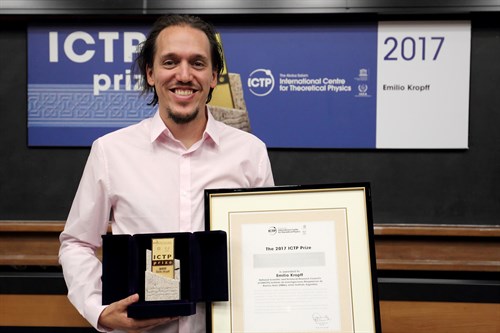
ICTP recently held an award ceremony for the recipient of its 2017 ICTP Prize, the Argentinian neuroscientist Emilio Kropff, for his outstanding contributions to the field.
After completing his studies in physics at the University of Buenos Aires, Kropff went on to earn a doctorate in cognitive neuroscience at SISSA in 2007. He worked as a postdoc at the Norwegian University of Science and Technology under the direction of 2014 Nobel Laureates May-Britt Moser and Edvard I. Moser. He is now a researcher at the National Scientific and Technical Research Council’s (CONICET) Instituto de Investigaciones Bioquimicas de Buenos Aires (IIBBA), Leloir Institute in Buenos Aires, as well as an ICTP Associate, collaborating with the Centre's Quantitative Life Sciences section.
Kropff's work addresses several aspects of memory and spatial cognition, combining both experimental and theoretical approaches. Most notably, Kropff discovered speed cells in the brain's entorhinal cortex, neurons that encode a high-precision measurement of speed, publishing his results in Nature in 2015.
In this interview, he shares with us some of his research interests, his passion for neural networks, and a handful of good memories he retains of Trieste.
You originally studied physics, then moved to neuroscience. Has the number of people coming from diverse scientific backgrounds increased in the field of neuroscience in recent years?
It is true that many physicists adventure to other fields and are often lost or feel as outsiders. Luckily, neuroscience is nowadays a field that nobody can claim as its own, so it openly accepts contributions from all over the world of science. I have had colleagues with a wide collection of backgrounds: biology, physics, genetics, electrical engineering, medicine, psychology, philosophy, and I hope to get further enriched by interacting with other disciplines.
What's the core topic of your current research?
The brain is a complex machinery and there is place for many different approaches into how it functions. Some people focus on how individual neurons do their job and what causes them not to perform well in specific situations. Other people like to study the brain as a whole, understand how different areas are connected and interact. My focus is on an intermediate scale, and I am not so interested in the hardware that allows the processing of information but in the software. What are the neural algorithms that small circuits (comprised of perhaps millions of neurons) are trying to implement? What can we know about this software by probing ten or twenty neurons while an animal performs a task, such as solving a maze? This is my own original contribution to the field. Some of the questions I am interested in are the following: how is a memory created? How does an animal keep track of its own position as it navigates? How are these two processes affected by social interactions? Luckily, all of these questions can be approached by studying a single area of the mammalian brain, a structure called the hippocampus.
When did you first become interested in studying the hippocampal activity?
The hippocampus is one of the long-term obsessions of Alessandro Treves, my PhD supervisor at SISSA, and also one of the best known areas of the brain. It is a great network to study, from a theoretical point of view, because it is not tuned to interact directly with the outer world, but rather processes abstract information, already digested by the corresponding sensory or motor areas. For this reason it has access to a rich variety of information, which it treats in a general way. One could think that whatever an animal is interested in at a given moment is being represented in the hippocampus, and that this area applies the same processing strategy to all kinds of inputs.
Your website says that you initially were interested in neural networks and robotics as a young scientist. Do you have any plans to tie robotics into your current work or work with roboticists?
I would love to, and I am sometimes disappointed with the fact that a day has only 24 hours. In particular, a lot of what we are learning about how an animal explores and gets familiarized with a new environment would be helpful in the design of the next generation of home appliances. To navigate inside a house or an apartment, a GPS is not very useful, mainly because of its low spatial resolution and the complex navigational routes that domestic life requires. Appliances that navigate inside our homes will need some inspiration from the way in which mammals learn and interact with the environment. After all, we or our pets can optimize trajectories in a new home or a new office without a satellite watching us from above.
During your PhD at SISSA you became interested in how memories about the real world can be stored. What did you find out?
In theoretical models, items that a network has to memorize are constructed artificially, so that each item is completely different from the others. In other words, representations of those items are 'orthogonal'. However, in the real world, items are very similar to each other. Faces are more similar than dissimilar. Animals, plants, tools, they all have a huge number of common features that we cannot neglect. There is a complex structure in the database, and a non-trivial set of correlations. It turns out that this issue can be overcome in two ways, and both have pros and cons. One way is to represent items as they come from the real world, including the overlaps and non-trivial correlations, which is very useful when we have to interact with them. What Prof. Treves and I showed during my PhD is that in order to memorize this kind of database we need constant and careful re-adjustments. The incorporation of a new memory affects the network globally, including the parameters adjusted for memorizing other items. In this context, one-shot learning is impossible or severely limited. This is, however, the strategy probably taken by our cortex.
Are we capable of one-shot learning too?
We are certainly capable of one-shot learning, for example we can recognize the face of someone we met at a party two years ago. In this case, the alternative strategy is to change the code in which we represent items. For example, when we zip a file in our computer we are optimizing the code so as to use as little space as possible. Many of us think that in the hippocampus an optimization of a different nature is taking place. Its purpose is to represent each item in the most distant way from the others as possible, in other words to 'orthogonalize' representations. This code would not be a very practical one to interact with the world, since items such as 'dog', 'cat' and 'constitutional referendum' would all be equally different from (and equally similar to) each other. But it would allow for one-shot learning and with time information could be re-converted into its original code and passed to the cortex. On the other side, evidence suggests that hippocampal representations are not accessible to our conscious experience, so we do not need to worry about this strange and meaningless code, except for, perhaps, in our dreams.
Talking about memories, what are the best ones you retain of Trieste?
My time is Trieste was one of the best ones in my life. I shared a huge flat in Piazza Venezia with wonderful people, and had a view of Miramare castle from my window. I remember the day I woke up, during my first year at SISSA, only to find that the place had been taken over by Alpini. I used to sing in the choir 'Novo Accordo' and we made numerous, unforgettable trips through Friuli and Istria. However, let me pick one more abstract memory. As time goes by, there are some forms of memory that persist over others. In that sense, the perfume of the Adriatic seashore during summer nights is something I will always carry with me, wherever I go.
 |
Created in 1982, the ICTP Prize, recognizes young scientists (under 40) from developing countries who work and live in those countries and who have made outstanding and original contributions to physics. The prize includes a sculpture, a certificate and a cash award.
--- Anna Lombardi & Kelsey Calhoun
















